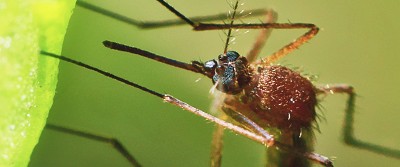The Adverse Effects of Mosquito Repellants

By Iva Fedorka
Controlling mosquito bites is part of the public health goal to reduce the parasitic and viral diseases carried by these insects. Scientists recently studied the effects of common mosquito repellants on both mosquito larvae and on their aquatic predators to further assess the risks and benefits.
Need for Mosquito Repellants
Mosquito-borne viruses like Zika, dengue and chikungunya in the Americas have increased the use of chemical repellants. The active ingredients DEET (N,N-diethyl-m-toluamide) and picaridin (also known by other trade names) have been the most effective repellants for humans.
Unintended Effects?
Neither DEET nor picaridin is water soluble, but commercial preparations that make the repellants easier to apply can enter water systems and natural environments via sewage and graywater.
Both compounds typically biodegrade rapidly and are barely detectable in wastewater. Both DEET and picaridin have some antimicrobial properties, but the risks here are also low. Picaridin toxicity to rainbow trout, zebrafish, green algae and water fleas has been tested before, and the endpoints were found to be very low (measured in milligrams per liter).
Test Protocol
Rafael Almeida, an ecologist at Cornell University in Ithaca, NY, wanted to know whether repellents containing DEET or picaridin affect aquatic wildlife. He set up a study to measure the effects on mosquito larvae and the salamander larvae that eat them.
Mosquito larvae from several species were collected and transported to the laboratory. Larvae of the spotted salamander were also collected. Groups of 30 mosquito and 9 salamander larvae were added to a series of containers, and a different dilution of one of the mosquito repellants was added to each container.
The larval salamanders were tested when they were mature enough to swim and forage, and external gills and forelimb buds were visible. The experiment lasted for 25 days, and stopped when the mosquito larvae started to pupate.
Unexpected Findings
Almeida and his colleagues found that the larval mosquitos were not affected by exposure to DEET- or picaridin-containing repellants.
The salamanders in the control group and those exposed to DEET all survived the experiment. However, the picaridin-treated amphibians died at a rate of 45 to 65 percent after 25 days of exposure. Salamander larvae exposed to picaridin also began to exhibit tail deformities and impaired development after only four days of exposure. (Kinked or bent tails are a common indicator of developmental abnormality in amphibians.)
A Serious Situation
Salamanders are important known predators of mosquito larvae, and increased picaridin in surface waters may also reduce the number of salamanders, leading to more adult mosquitos. Salamanders have a much shorter breeding season than mosquitoes. Furthermore, their populations have already been declining globally in response to pollution, habitat loss, climate change, and other stressors.
Future studies could focus on the verification of the mortality rates under more-natural conditions, tests using later developmental stages of the salamander larvae, and examination of the sub-lethal effects of exposure on the salamander larvae.
To Repel or Not To Repel
Given the efficacy of picaridin as a mosquito repellant and its low risk to humans (when applied topically), there are clear benefits to its continued use. More investigation is needed to show whether those benefits offset the loss of natural predators that help to control the mosquito population.
Discussion Questions
- What would be a logical next step for these researchers?
- Could the salamanders have been affected by the repellant in the larvae they consumed (in addition to the repellant in the water)?
Vocabulary
- Antimicrobial
- Biodegradable
- Ecotoxicology
- Mesocosm